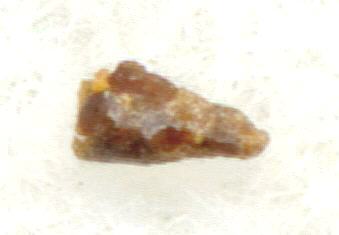NWA 011
AchondriteAn achondrite is a type of stony meteorite whose precursor was of chondritic origin and experienced metamorphic and igneous processes. They have a planetary or differentiated asteroidal origin where the chondritic parent body reached a sufficient size that through heating due to radioactive decay of 26Al (aluminum isotope) and gravitational Click on Term to Read More, ungroupedModifying term used to describe meteorites that are mineralogically and/or chemically unique and defy classification into the group or sub-group they most closely resemble. Some examples include Ungrouped Achondrite (achondrite-ung), Ungrouped Chondrite (chondrite-ung), Ungrouped Iron (iron-ung), and Ungrouped Carbonaceous (C-ung). Click on Term to Read More
carbonaceous chondrite-related
(EucriteMost common type of achondrite meteorite and a member of the HED group. Eucrites are basalts composed primarily of pigeonite and anorthite (An60-98). Eucrites have been placed into three subgroups based on mineralogical and chemical differences. • Non-cumulate eucrites represent the upper crust that solidified on a magma ocean after Click on Term to Read More in MetBull 84)
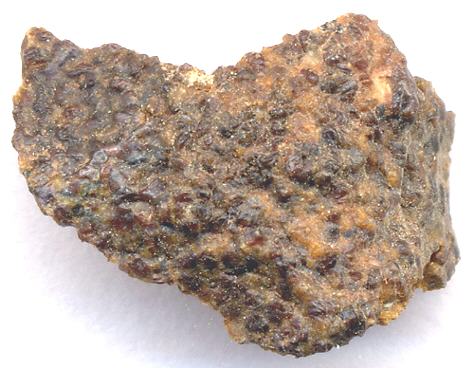
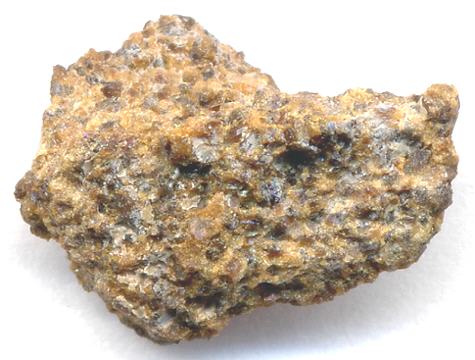
Purchased 1999
31° 20′ N., 4° 20′ W. Several small stones were purchased from a man in Rissani, Morocco by a Russian team during a meteoriteWork in progress. A solid natural object reaching a planet’s surface from interplanetary space. Solid portion of a meteoroid that survives its fall to Earth, or some other body. Meteorites are classified as stony meteorites, iron meteorites, and stony-iron meteorites. These groups are further divided according to their mineralogy and Click on Term to Read More expedition. Among these stones was a relatively fresh 40 g meteorite, designated NWA 011, which was analyzed and classified at the Vernadsky Institute, Moscow, by S. Afanasiev and M. Ivanova. Initially, the meteorite was classified as a highly metamorphosed, unbrecciated, noncumulate eucriteMost common type of achondrite meteorite and a member of the HED group. Eucrites are basalts composed primarily of pigeonite and anorthite (An60-98). Eucrites have been placed into three subgroups based on mineralogical and chemical differences. • Non-cumulate eucrites represent the upper crust that solidified on a magma ocean after Click on Term to Read More with Fe/Mn ratios of pyroxeneA class of silicate (SiO3) minerals that form a solid solution between iron and magnesium and can contain up to 50% calcium. Pyroxenes are important rock forming minerals and critical to understanding igneous processes. For more detailed information, please read the Pyroxene Group article found in the Meteoritics & Classification category. Click on Term to Read More significantly higher (~65) than other eucritesMost common type of achondrite meteorite and a member of the HED group. Eucrites are basalts composed primarily of pigeonite and anorthite (An60-98). Eucrites have been placed into three subgroups based on mineralogical and chemical differences. • Non-cumulate eucrites represent the upper crust that solidified on a magma ocean after Click on Term to Read More (30–50) (Afanasiev et al., 2000). A second, nearly identical stone weighing 137 g, NWA 2400, was also recovered, and it was determined to be most likely paired with NWA 011 (Bunch and Wittke, NAU; Irving and Kuehner, UWS; D. Rumble III, CIW). Further searches of the area have resulted in the recovery of more stones that are considered to be paired with NWA 011, including NWA 2976 (219 g), and NWA 4901 (24 g). One stone currently under analysis weighs 95 g, while another stone represents the largest known member of this pairing group—a 530 g stone designated NWA 4587, for which a 360°, 3-D image has been skillfully constructed by G. Hupé. Additionally, NWA 5644 (200 g), and NWA 7129 (50 g) have been classified as pairings. The cutting and distribution of NWA 011 is well documented (Inoue, Meteorite, August 2002). A 22.236 g end section that was offered for sale at the 2000 Denver Show attracted the attention of S. Inoue of Hori Mineralogy Ltd., who eventually purchased the piece on behalf of A. Yamaguchi of the National Institute of Polar Research and himself. This piece was cut into two sections—17.773 g was distibuted to NIPR, and the remaining 4.018 g slice was retained by HML. The remainder of the material, representing ~4–5 g, is included in the original slice. The other end section, which weighs 11.4 g, is curated at Vernadsky Institute. Northwest Africa 011 is primarily composed of coarse-grained pyroxene (58.5 vol%, as pigeoniteLow-Ca clinopyroxene, (Ca,Mg,Fe)SiO3, found as a major mineral in eucrites and shergottites. In order to be considered pigeonite, the clinopyroxene must contain 5 to 20 mol % of calcium (Wo5 - 20). Chondrites of petrologic types 4 and below contain significant low-Ca clinopyroxene. During metamorphism to higher temperatures, all existing and augiteHigh-Ca clinopyroxene, (Ca,Mg,Fe)SiO3, that occurs in many igneous rocks, particularly those of basaltic composition. In order to be considered augite, the clinopyroxene must contain 20 to 45 mol % of calcium (Wo20 - 45). An important and unique Martian meteorite is NWA 8159, that has been classified as an augite basalt. Click on Term to Read More) in fine-grained plagioclaseAlso referred to as the plagioclase feldspar series. Plagioclase is a common rock-forming series of feldspar minerals containing a continuous solid solution of calcium and sodium: (Na1-x,Cax)(Alx+1,Si1-x)Si2O8 where x = 0 to 1. The Ca-rich end-member is called anorthite (pure anorthite has formula: CaAl2Si2O8) and the Na-rich end-member is albite Click on Term to Read More (39.6 vol%, as bytownite), with minor quartzComposed of SiO2, quartz is one of the silica group minerals most common in Earth's crust, but never found in meteorites as inclusions visible to the naked eye. Quartz in meteorites has been found in very small quantities in eucrites, other calcium-rich achondrites, and in the highly reduced E chondrites1. Click on Term to Read More (0.7 vol%), Ca-phosphate (0.5 vol% as merrillite and chlorapatite), Fe-rich olivineGroup of silicate minerals, (Mg,Fe)2SiO4, with the compositional endpoints of forsterite (Mg2SiO4) and fayalite (Fe2SiO4). Olivine is commonly found in all chondrites within both the matrix and chondrules, achondrites including most primitive achondrites and some evolved achondrites, in pallasites as large yellow-green crystals (brown when terrestrialized), in the silicate portion Click on Term to Read More (trace), and opaques (0.7 vol%) including ilmeniteTi-Fe oxide, TiFeO3, found in achondrites, lunar mare basalts, and shergottites. Ilmenite forms as a primary mineral in mafic igneous rocks. It crystallizes relatively early out of a magma before most of the other minerals, and as a result, the heavier crystals of ilmenite precipitate to the bottom of the magma Click on Term to Read More, troiliteBrass colored non-magnetic mineral of iron sulfide, FeS, found in a variety of meteorites. Click on Term to Read More, Ti-rich chromiteBrownish-black oxide of chromium and iron (Cr-Fe oxide), Cr2FeO4, found in many meteorite groups. Click on Term to Read More, and ulvöspinelMg-Al oxide, MgAl2O4, found in CAIs.). The presence of igneously-zoned plagioclase laths suggests a complicated petrogenesis, in accord with a history that includes low degrees of fractional crystallizationA crystallization process in which minerals crystallizing from a magma are isolated from contact with the liquid. It is a key process in the formation of igneous rocks during the process of magmatic differentiation. Also known as crystal fractionation. Click on Term to Read More of a partial melt, brecciationThe formation of a breccia through a process by which rock fragments of of various types are recemented or fused together. Click on Term to Read More and recrystallization, possibly in an impact-melt event (Yamaguchi, 2001), culminating with a period of annealing. Subsequent to this, another heating event occurred, during which olivine grains formed, and this was followed by rapid cooling likely due to impact excavation (Sugiura and Yamaguchi, 2007). During the first thermal event, Ca-phosphates and ilmenite were mobilized from the original mesostasisLast material to crystallize/solidify from a melt. Mesostasis can be found in both chondrules, in the matrix around chondrules, and in achondrites as interstitial fine-grained material such as plagioclase, and/or as glass between crystalline minerals. Click on Term to Read More into the plagioclase assemblages of the recrystallized rock. Similarly, some REEOften abbreviated as “REE”, these 16 elements include (preceded by their atomic numbers): 21 scandium (Sc), 39 Yttrium (Y) and the 14 elements that comprise the lanthanides excluding 61 Promethium, an extremely rare and radioactive element. These elements show closely related geochemical behaviors associated with their filled 4f atomic orbital. Click on Term to Read More homogenization occurred within pyroxenes. This history of thermal metamorphism presumed for NWA 011 is almost identical to that proposed for the highly metamorphosed eucrites EET 90020 and Y-86763, and the ungrouped eucrite-like Ibitira, and it suggests that they were similar early crustal rocks on their respective parent bodies. A consortium study was carried out by various researchers to measure the O-isotopes, elemental abundances, and CRE age of NWA 011. The plot on an oxygenElement that makes up 20.95 vol. % of the Earth's atmosphere at ground level, 89 wt. % of seawater and 46.6 wt. % (94 vol. %) of Earth's crust. It appears to be the third most abundant element in the universe (after H and He), but has an abundance only Click on Term to Read More 3-isotope diagram is very distant from that of the eucrites, but is more similar to the CR chondritesChondrites are the most common meteorites accounting for ~84% of falls. Chondrites are comprised mostly of Fe- and Mg-bearing silicate minerals (found in both chondrules and fine grained matrix), reduced Fe/Ni metal (found in various states like large blebs, small grains and/or even chondrule rims), and various refractory inclusions (such Click on Term to Read More (Promprated et al., 2003) and also near the acapulcoite–lodraniteRare type of primitive achondrite named after the Lodran meteorite that fell in Pakistan in 1868. Initially, lodranites were grouped with the stony-iron meteorites because they contain silicates (olivine, orthopyroxene, and minor plagioclase) and Fe-Ni metal in nearly equal proportions. However, since discovery of the closely related acapulcoite group, lodranites Click on Term to Read More clan. However, elemental abundances in NWA 011 are likely the result of fractional crystallizationPhysical or chemical process or action that results in the formation of regularly-shaped, -sized, and -patterned solid forms known as crystals. Click on Term to Read More rather than partial meltingAn igneous process whereby rocks melt and the resulting magma is comprised of the remaining partially melted rock (sometimes called restite) and a liquid whose composition differs from the original rock. Partial melting occurs because nearly all rocks are made up of different minerals, each of which has a different melting Click on Term to Read More processes that occurred on the acapulcoite–lodranite body (Floss et al., 2005). Oxygen isotopeOne of two or more atoms with the same atomic number (Z), but different mass (A). For example, hydrogen has three isotopes: 1H, 2H (deuterium), and 3H (tritium). Different isotopes of a given element have different numbers of neutrons in the nucleus. Click on Term to Read More mixing models suggest that a close compositional match can be obtained by blending components of Allende with either H or LL chondriteOrdinary chondrites ("low Fe" / "low metal") with only 1 to 3% free metal. Their olivine is more Fe-rich than in the other ordinary chondrites (Fa27-32), implying that the LL types must have formed under more oxidizing conditions than their H or L cousins. Orthopyroxene compositions are also Fe-the rich Click on Term to Read More material (Boesenberg, 2003). This model also calls for the sequestration of a larger amount of metalElement that readily forms cations and has metallic bonds; sometimes said to be similar to a cation in a cloud of electrons. The metals are one of the three groups of elements as distinguished by their ionization and bonding properties, along with the metalloids and nonmetals. A diagonal line drawn Click on Term to Read More and olivine to the coreIn the context of planetary formation, the core is the central region of a large differentiated asteroid, planet or moon and made up of denser materials than the surrounding mantle and crust. For example, the cores of the Earth, the terrestrial planets and differentiated asteroids are rich in metallic iron-nickel. Click on Term to Read More than is considered to have occurred on the eucrite parent bodyThe body from which a meteorite or meteoroid was derived prior to its ejection. Some parent bodies were destroyed early in the formation of our Solar System, while others like the asteroid 4-Vesta and Mars are still observable today. Click on Term to Read More. Additional constraints on the origin of this meteorite have been established through studies of the Cr-isotopic systematics. The resulting ε54Cr value of +1.35 (±0.11) measured by Bogdanovski and Lugmair (2004) resolves NWA 011 from the acapulcoite–lodranite clan (ε54Cr = –0.75; Göpel and Birck, 2010), a meteorite group for which discrimination through the use of O-isotopic values had not been attained. Warren (2011) determined that the isotope signatures of Δ17O, ε54Cr, ε50Ti, and ε62Ni can be utilized to resolve carbonaceous from non-carbonaceous meteorites; the carbonaceous meteorites have positive values for all of these elements, while the non-carbonaceous meteorites have negative values. Examples of coupled 50Ti diagrams are shown below to demonstrate the separation between carbonaceous and non-carbonaceous meteorites; it can be seen that NWA 011 plots in the carbonaceous field. Comparison of Titanium and Oxygen Isotope Compositions
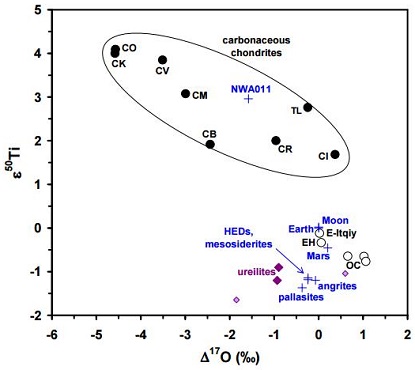
Diagram credit: P. Warren, GCA, vol. 75, Fig. EA-3 (2011)
‘Stable isotopes and the noncarbonaceous derivation of ureilites, in common with nearly all differentiated planetary materials’
(http://dx.doi.org/10.1016/j.gca.2011.09.011)
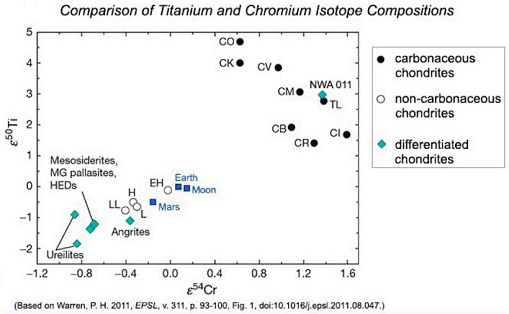
In its bulk composition, NWA 011 is significantly different from typical eucrites in the following ways: it has a higher P content, a higher siderophile elementLiterally, "iron-loving" element that tends to be concentrated in Fe-Ni metal rather than in silicate; these are Fe, Co, Ni, Mo, Re, Au, and PGE. These elements are relatively common in undifferentiated meteorites, and, in differentiated asteroids and planets, are found in the metal-rich cores and, consequently, extremely rare on content, a higher mean Fe/Mn ratio in pyroxene (~65 for NWA 011 vs. ~28–40 for typical eucrites), a lower Sc content, and a higher abundance of platinum group elementsElements with geochemical properties similar to Pt (platinum) including Ru, Rh, Pd, Os, Ir, and sometimes Au. These occur in nature in close association with one another and with Ni and Cu. They are among the least abundant of the Earth’s naturally occurring elements. Click on Term to Read More. In addition, it has an excess of 50Ti and 54Cr (Trinquier et al., 2007). All of these features suggest a more oxidizedOxidation and reduction together are called redox (reduction and oxidation) and generally characterized by the transfer of electrons between chemical species, like molecules, atoms or ions, where one species undergoes oxidation, a loss of electrons, while another species undergoes reduction, a gain of electrons. This transfer of electrons between reactants Click on Term to Read More source than that for typical eucrites (Korotchantseva et al., 2003; Isa et al., 2008). Based on elemental abundance patterns, the PGEElements with geochemical properties similar to Pt (platinum) including Ru, Rh, Pd, Os, Ir, and sometimes Au. These occur in nature in close association with one another and with Ni and Cu. They are among the least abundant of the Earth’s naturally occurring elements. Click on Term to Read More enrichment as well as the higher abundances of other siderophile elements has been conjectured to be the result of an impact mixing event on the NWA 011 parent body involving a group-IVB iron projectile (Yamaguchi et al., 2002). In addition, the trace elementSubstance composed of atoms, each of which has the same atomic number (Z) and chemical properties. The chemical properties of an element are determined by the arrangement of the electrons in the various shells (specified by their quantum number) that surround the nucleus. In a neutral atom, the number of Click on Term to Read More contents of NWA 011 are distinct from those of other eucrites—it has a higher Sr content, a lower REE content in merrillite, and a smaller Eu anomaly in pyroxene and phosphate (Floss et al., 2004). The Th/U ratio of NWA 011 is significantly lower than that of other basaltic meteorites such as eucrites and angrites. In addition, a positive Ce anomaly in merrillite is consistent with formation in an oxidizingOxidation and reduction together are called redox (reduction and oxidation) and generally characterized by the transfer of electrons between chemical species, like molecules, atoms or ions, where one species undergoes oxidation, a loss of electrons, while another species undergoes reduction, a gain of electrons. This transfer of electrons between reactants Click on Term to Read More environment. The Mn–Cr isotope systematics were studied by Bogdanovski and Lugmair (2003, 2004), and they found significant differences (much lower abundances of each) between NWA 011 and the HED group, providing further persuasive evidence against a genetic relationship. Interestingly, their 54Cr data are similar to those from CR carbonaceous chondrites, indicating a strong probability for an origin on a differentiated CR-like carbonaceous chondriteCarbonaceous chondrites represent the most primitive rock samples of our solar system. This rare (less than 5% of all meteorite falls) class of meteorites are a time capsule from the earliest days in the formation of our solar system. They are divided into the following compositional groups that, other than Click on Term to Read More parent body. Continued research on this front has been ongoing (e.g., Bunch et al., 2005, [#2308]; Floss et al., 2005, [MAPS Vol 40, #3]; Irving et al., 2014 [#2465]; Sanborn et al., 2014 [#2032]). As provided in the Sanborn et al. (2014) abstract, a Δ17O vs. ε54Cr diagram is one of the best diagnostic tools for determining genetic relationships between meteorites. Moreover, Sanborn et al. (2015) demonstrated that ε54Cr values are not affected by aqueous alteration. It is apparent in the diagrams below that the paired stones NWA 011 and 2976 plot within the CR chondriteClass named for the Renazzo meteorite that fell in Italy in 1824, are similar to CMs in that they contain hydrous silicates, traces of water, and magnetite. The main difference is that CRs contain Ni-Fe metal and Fe sulfide that occurs in the black matrix and in the large chondrules Click on Term to Read More field. In addition to the Cr data, the enriched Fe content of NWA 011 also excludes the planetThe term "planet" originally comes from the Greek word for "wanderer" since these objects were seen to move in the sky independently from the background of fixed stars that moved together through the seasons. The IAU last defined the term planet in 2006, however the new definition has remained controversial. Click on Term to Read More Mercury as the parental source. Moreover, by utilizing the Mn–Cr data they were able to calculate the time at which differentiationA process by which a generally homogeneous chondritic body containing mostly metal, silicates and sulfides will melt and form distinct (differentiated) layers of different densities. When the melting process continues for a long enough period of time, the once chondritic body will re-partition into layers of different composition including Click on Term to Read More occurred and the parental source reservoir of NWA 011 was formed, which occurred ~4.563 b.y. ago.
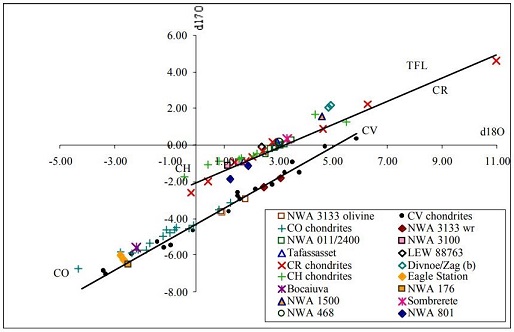
click on image for a magnified view Diagram credit: Bunch et al., 36th LPSC, #2308 (2005)
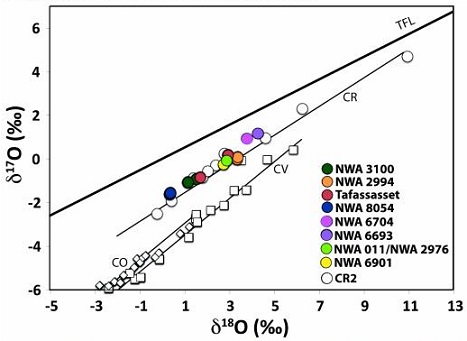
Diagram credit: Sanborn et al., 45th LPSC, #2032 (2014) 17O vs. ε54Cr and ε50Ti for CR Carbonaceous Achondrites
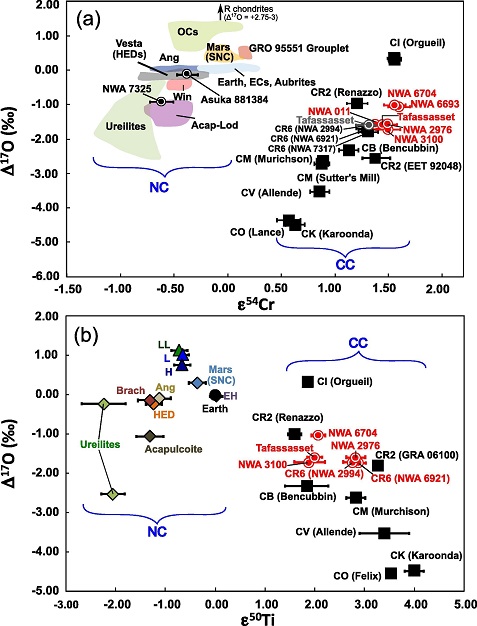
click on image for a magnified view Diagrams credit: Sanborn et al., GCA, vol. 245, pp. 577–596 (2019)
‘Carbonaceous Achondrites Northwest Africa 6704/6693: Milestones for Early Solar SystemThe Sun and set of objects orbiting around it including planets and their moons and rings, asteroids, comets, and meteoroids. Chronology and Genealogy’
(https://doi.org/10.1016/j.gca.2018.10.004) In an isotope systematics study, Sugiura and Yamaguchi (2007) reported the Mn–Cr age for NWA 011 as 4.5623 (±0.0026) b.y., while the Al–Mg age was calculated to be 4.5627 (±0.0003) b.y. Other Al–Mg age results include 4.5633 (±0.0005) b.y., determined by Schiller et al. (2010), and 4.56310 (±0.00038) b.y., determined by Bouvier et al. (2011) for the paired meteorite NWA 2976. The Sugiura and Yamaguchi (2007) ages are concordant with each other, and likely represent the meteorite’s crystallization age 3–5 m.y. after CAISub-millimeter to centimeter-sized amorphous objects found typically in carbonaceous chondrites and ranging in color from white to greyish white and even light pink. CAIs have occasionally been found in ordinary chondrites, such as the L3.00 chondrite, NWA 8276 (Sara Russell, 2016). CAIs are also known as refractory inclusions since they Click on Term to Read More formation; such an early crystallization would be consistent with an asteroidal origin rather than a planetary origin (Scott et al., 2009). In addition, these ages are nearly identical to the ages calculated for the oldest eucrites and the quenched angrites such as Sahara 99555. The Sm–Nd age of NWA 011, calculated to be 4.46 (±0.04) b.y. (Nyquist et al., 2003), is younger than the calculated Mn–Cr and Al–Mg ages, possibly reflecting late metamorphicRocks that have recrystallized in a solid state due to changes in temperature, pressure, and chemical environment. Click on Term to Read More resetting. A more precise crystallization age was calculated by Bouvier et al. (2011) utilizing the paired NWA 2976. Employing the 238U/235U value of 137.751, the absolute Pb–Pb age was calculated to be 4.56289 (±0.00059) b.y. This age is concordant with the Al–Mg age anchored to the D’Orbigny angriteType of evolved achondrite meteorite that represent some of the earliest stages of asteroidal differentiation and magmatism in our solar system. Angrites are named for the Angra dos Reis meteorite, which fell in Rio de Janeiro, Brazil, in early 1869. They are basaltic (mafic) rocks, often containing porous areas, and Click on Term to Read More and a Type B CAI from the CV3 chondriteChondrites are the most common meteorites accounting for ~84% of falls. Chondrites are comprised mostly of Fe- and Mg-bearing silicate minerals (found in both chondrules and fine grained matrix), reduced Fe/Ni metal (found in various states like large blebs, small grains and/or even chondrule rims), and various refractory inclusions (such Click on Term to Read More NWA 2364. This likely represents the crystallization age of the basaltic meteorite in the crustOutermost layer of a differentiated planet, asteroid or moon, usually consisting of silicate rock and extending no more than 10s of km from the surface. The term is also applied to icy bodies, in which case it is composed of ices, frozen gases, and accumulated meteoritic material. On Earth, the Click on Term to Read More of this parent asteroid. Further studies have been conducted by Sanborn et al. (2018) of new anomalous ungrouped meteorites recovered in Northwest Africa. Utilizing a coupled Δ17O vs. ε54Cr diagram, they demonstrated that NWA 011 and pairings, NWA 6704 and pairings, and NWA 6962/7680 all plot within the CR/CH carbonaceous chondrite field represented by CR2 Renazzo and CH3 NWA 2210, which suggests that a genetic relationship exists among them (see diagram below). Chromium vs. Oxygen-isotope Plot
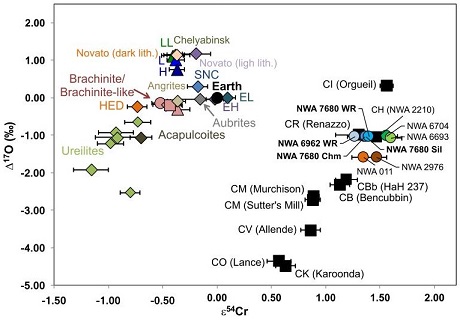
click on image for a magnified view Diagram credit: Sanborn et al., 49th LPSC, #2296 (2018) Moreover, Sanborn et al. (2018) determined that the absolute Mn– Cr age (anchored to D’Orbigny) calculated for NWA 6962/7680 (4.56376 [±0.00176] b.y.) is concordant with the ages calculated for NWA 011 and NWA 6704. It has been proposed by many investigators that a large (~400 km diameter) differentiated CR parent body formed in the early history of the Solar SystemDefinable part of the universe that can be open, closed, or isolated. An open system exchanges both matter and energy with its surroundings. A closed system can only exchange energy with its surroundings; it has walls through which heat can pass. An isolated system cannot exchange energy or matter with and subsequently experienced a collisional disruption. For more information pertaining to this scenario, see the LPSC abstract ”Primitive’ and igneous achondrites related to the large and differentiated CR parent body’ by Bunch et al. (2005), the MetSoc abstract ‘Tafassasset and Primitive Achondrites: Records of Planetary Differentiation’ by Nehru et al. (2014), and the LPSC abstract ‘Collisional Disruption of a Layered, Differentiated CR Parent Body Containing Metamorphic and Igneous Lithologies Overlain by a Chondrite Veneer’ by Irving et al. (2014). The noble gasElement occurring in the right-most column of the periodic table; also called "inert" gases. In these gases, the outer electron shell is completely filled, making them very unreactive. Click on Term to Read More data of NWA 011 reveal both a young isochron age of ~800 m.y., which might reflect Ar redistribution and adsorptionAdhesion of a species onto the surfaces of particles. Click on Term to Read More in this meteorite due to terrestrial weathering effects, and a gas retention age of ~3.2–3.9 b.y., which is not resolvable from that of the HED meteorites (Bogard and Garrison, 2004; Korochantseva et al, 2005). However, some data is consistent with a gas retention isochron as young as ~3.1–3.2 b.y. old, which is later than the Late Heavy BombardmentPeriod between ~4.0 to 3.8 Ga ago when the Moon and other objects in the Solar System were pounded heavily by wayward asteroids. The evidence for the Late Heavy Bombardment (LHB) includes the lunar maria basins and similar structures elsewhere, such as the Caloris Basin on Mercury and the great Click on Term to Read More period as evidenced by most eucrites and the Moon. An initial CRE age of 22.2 (±3.3) m.y. was calculated for NWA 011, an age which falls within one of the five common breakup events determined for the HED PB (Patzer et al., 2003). Subsequent studies by two other research groups calculated 21Ne-derived and 38Ar-derived CRE ages of ~28–30 m.y. for NWA 011 (Yamaguchi et al., 2002 and Korochantseva et al, 2005), which also fallMeteorite seen to fall. Such meteorites are usually collected soon after falling and are not affected by terrestrial weathering (Weathering = 0). Beginning in 2014 (date needs confirmation), the NomComm adopted the use of the terms "probable fall" and "confirmed fall" to provide better insight into the meteorite's history. If Click on Term to Read More near an established HED age cluster. From these and other comparisons, it may be assumed that NWA 011 is an ungrouped basaltic or possibly gabbroic achondrite that originated from a relatively large parent body other than 4 VestaThird largest and fourth brightest asteroid; it was discovered in 1807 by Heinrich Olbers and named for the ancient Roman goddess of the hearth. 4 Vesta has a basaltic surface composition and an average density not much less than that of Mars. Evidently lava once flowed here indicating that the, which was located in a different region of the solar nebulaThe primitive gas and dust cloud around the Sun from which planetary materials formed., and which experienced a similar petrologic history and had a similar mineralogy. Its CR-like O-isotopic composition and similarity to some metamorphosed eucrites suggests an asteroidal origin in the outer solar system. The possibility of an origin on the ~17 km diameter basaltic asteroid 1459 Magnya, located at ~3.15 AUThe astronomical unit for length is described as the "mean" distance (average of aphelion and perihelion distances) between the Earth and the Sun. Though most references state the value for 1 AU to be approximately 150 million kilometers, the currently accepted precise value for the AU is 149,597,870.66 km. The Click on Term to Read More, was raised by Nyquist et al., 2003, but the Sm–Nd data favor a larger parent body. Other differentiated and disrupted parent bodies have been identified in the central main beltBelt located between 2.12 and 3.3 AU from the Sun and located between the orbits of Mars and Jupiter containing the vast majority of asteroids. The asteroid belt is also termed the main asteroid belt or main belt to distinguish it from other asteroid populations in the Solar System such Click on Term to Read More (Bottke et al., 2006). These include the S-type, high-Ca pyroxene asteroids 17 Thetis, 847 Agnia, and 808 Merxia, as well as some possible exposed iron cores such as 16 Psyche and 216 Kleopatra. A very small amount of mantleMain silicate-rich zone within a planet between the crust and metallic core. The mantle accounts for 82% of Earth's volume and is composed of silicate minerals rich in Mg. The temperature of the mantle can be as high as 3,700 °C. Heat generated in the core causes convection currents in Click on Term to Read More material would be expected to survive the long journey from this distant region of the asteroid beltBelt located between 2.12 and 3.3 AU from the Sun and located between the orbits of Mars and Jupiter containing the vast majority of asteroids. The asteroid belt is also termed the main asteroid belt or main belt to distinguish it from other asteroid populations in the Solar System such Click on Term to Read More. Scott et al. (2009) surmise that the parent asteroids of NWA 011 and other ungrouped basaltic achondrites, along with most of the thousands of other Vesta-like bodies that probably occupied the early asteroid belt, were likely removed from the belt in early Solar System history through gravitational perturbations. Previous to the asteroid’s removal, crustal portions may have been ejected to form small ~10 km diameter objects from which unbrecciated samples could subsequently be made available for capture by Earth. A transmitted light view of a petrographic thin sectionThin slice or rock, usually 30 µm thick. Thin sections are used to study rocks with a petrographic microscope. of the paired stone NWA 2976 can be seen on J. Kashuba’s page. The top photo shown above is an enlarged image of a 0.001 g (1 mg) portion of NWA 011 acquired from the first known stone. The other two photos show both the fusion-crusted side and an interior view of a 0.56 g fragment from one of the pairings of this meteorite. My thanks to meteorite procurer extraordinaire, Aziz Habibi, who kindly contributed this specimen to this collection. Thanks to R. A. Langheinrich Meteorites for kindly pursuing the initial sample of this scientifically important meteorite from S. Afanasiev, Vernadsky Institute of GeochemistryStudy of the chemical composition of Earth and other planets, chemical processes and reactions that govern the composition of rocks and soils, and the cycles of matter and energy that transport Earth's chemical components in time and space. Click on Term to Read More and Analytical Chemistry.






